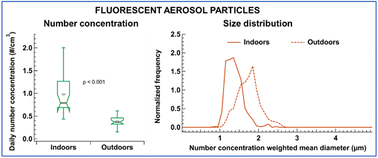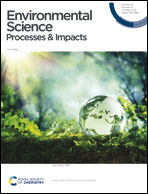Assessing residential indoor and outdoor bioaerosol characteristics using the ultraviolet light-induced fluorescence-based wideband integrated bioaerosol sensor
Abstract
We assessed and compared indoor and outdoor residential aerosol particles in a third-floor apartment from August through September 2020. The measurements were conducted using a direct-reading ultraviolet light-induced fluorescence (UV-LIF) wideband integrated bioaerosol spectrometer (WIBS). It measures individual particle light scattering and fluorescence from which particle properties can be derived. The number concentrations of total aerosol particles (TAP) and total fluorescent aerosol particles (TFAP) were significantly higher indoors. Daily and hourly TFAP mean concentrations followed the same trends as the TAP, both indoors and outdoors. The daily mean rank of the TFAP fraction (TFAP/TAP) was significantly higher indoors (23%) than outdoors (19%). Particles representing bacteria dominated indoors while particles representing fungi and pollen dominated outdoors. The mean volume-weighted median diameters for TFAP were 1.67 μm indoors and 2.09 μm outdoors. Higher TFAP fraction indoors was likely due to occupants' activities that generated or resuspended particles. This study contributes to understanding the characteristics of residential aerosol particles in situations when occupants spend most of their time indoors. Based on our findings, a large portion of all indoor aerosol particles could be biological (15–20%) and of respirable particle size (≥95%). Using a novel direct reading UV-LIF-based sensor can help quickly assess aerosol exposures relevant to human health.

- This article is part of the themed collections: Environmental exposure and impacts and Environmental Science – coronavirus research


 Please wait while we load your content...
Please wait while we load your content...